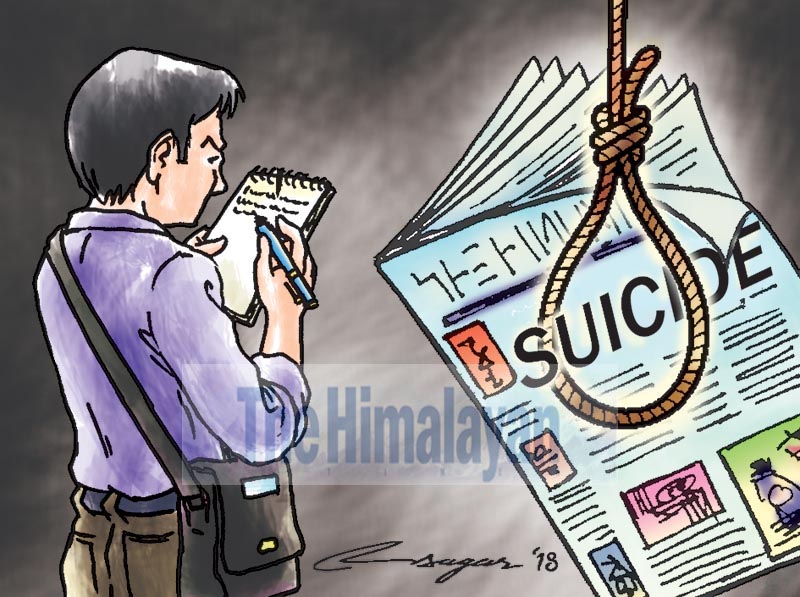Growing suicides: Can we prevent them?
The statistics are quite alarming in that more than 10 per cent of the reported cases are of children or adolescents. There were five media reports of childhood suicide in the last few months in Kathmandu alone
"Why did you save me, doctor? I want to die…... I don’t want to live…….”
A 21-year-old college student, who recently had a break-up in his relationship, was talking to me three days after his admission in our hospital for trying to hang himself.
Such incidents are not unusual to us: A woman having frequent quarrels with her drunken husband; a student having failed the SLC; a grief-stricken mother who had lost her only son; a bankrupt businessman.
Cases of suicide attempt are very common in our Psychiatry Department. The most common method is organophosphorus poisoning, mainly during the agricultural season. Other measures are hanging, drowning and shooting oneself.
A past publication of mine showed 73 cases of attempted suicide, or intentional self-harm (ISH), within a six-month period in our hospital. These ISH cases, after being clinically stable, are seen by us (psychiatrists), for any psychiatric illnesses they might have and offer suitable treatments, such as psychotherapy and medication.
Both clinical experience and established medical literature show suicide to be mostly associated with psychiatric conditions. Common psychiatric conditions leading to suicide are depression, bipolar affective disorder, schizophrenia and substance use disorders. Also suicide attempts are frequent symptoms of impulsive, borderline and histrionic personality disorders.
Having said that, we can claim that if we diagnose those psychiatric disorders in time and treat them with established measures, suicides can be prevented. The main goal of any psychiatric care is not only the prevention of potential psychiatric complications like suicides but also precluding possible future suicidal acts among current suicide attempters. It is said that there is a 50 per cent chance of a suicide-attempter repeating the act.
Suicide is a huge public health and social problem worldwide - the second most important global cause of adolescent death following the road traffic accidents. Nepal is among the top 10 suicide-prone countries in the world. According to police records, there were 2,025 suicidal deaths in 2075/76 BS. The figures were 5,346 in 2074/75 and 5,131 in 2073/74 BS. But these are only recorded suicides available with the Home Ministry.
In view of our socio-cultural environment and substantial effects of stigma and discrimination on the Nepali people, we can assume many more suicide cases might have gone
unreported. The statistics are quite alarming in that more than 10 per cent of the reported cases are of children or adolescents. There were about five media reports of childhood suicide in the last couple of months in the Kathmandu Valley alone. Isn’t it disturbing to note that youngsters in this country are killing themselves?
Our hospital records also echo similar data. Our emergency department comes across mainly teenagers, women, love-or-exam failures and those with impulsive or borderline traits. We also become shocked or compassionate when we have to hear that our patients, who did not attend the follow-ups for several months, had committed suicide. Psychiatric conditions requiring prolonged (lifelong) medication, like bipolar disorder, or conditions in which the treatment enhances the patient’s lost insights on their illnesses, like schizophrenia, have shown that the patients usually end their life by suicide. However, such incidents are also preventable if we ensure regular follow-ups, provide psycho-education, and timely family or community interventions.
Despite these, there are some misconceptions related to suicide, which need to be erased if we are to aim for a suicide-free society. They are: talking about suicide with the patients will increase its chance; those who talk about ending their life really don’t do so; all those who commit suicide are mentally ill; those who have already decided to end their life can never be stopped; and those who commit suicide are cowards who want to run away from their responsibility or flee from their society.
All these are myths. The reality is: Talking about suicide actually provides confidence to the patients to freely communicate their inner feelings and pain. The patients will be encouraged to express their suicidal thoughts. Those who commit suicide usually give some clues beforehand while talking regarding their depressive cognitions like helplessness, hopelessness, worthlessness and death wishes. Proper communication can tap those clues and plan proper treatment.
Though there is a strong association between suicide and psychiatric disorders, all suicide -attempters or committers are not mentally ill. But they need our help. Empathic listening, good communication skills and proper treatment can really stop the suicidal impulses or postpone or halt the suicidal acts even in those who strongly want to end their life. Suicide attempters or committers are not cowards. Rather they are help-seekers, who actually need proper counseling, treatment and care from us.
If we consider all these issues, we can prevent suicides. This is what we need to advocate to all those concerned - doctors, teachers, lawyers, politicians and media people.
Dr Risal is a psychiatrist at Dhulikhel Hospital






